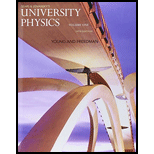
University Physics with Modern Physics, Volume 1 (Chs. 1-20) and Mastering Physics with Pearson eText & ValuePack Access Card (14th Edition)
14th Edition
ISBN: 9780134209586
Author: Hugh D. Young
Publisher: PEARSON
expand_more
expand_more
format_list_bulleted
Question
Chapter 41, Problem 41.22E
(a)
To determine
The magnetic interaction energy of the electro with the field.
b)
To determine
Whether there is any orbital magnetic dipole moment interaction for the state and whether there can be orbital magnetic dipole moment interaction for
Expert Solution & Answer
Want to see the full answer?
Check out a sample textbook solution
Students have asked these similar questions
A capacitor with a capacitance of C = 5.95×10−5 F is charged by connecting it to a 12.5 −V battery. The capacitor is then disconnected from the battery and connected across an inductor with an inductance of L = 1.55 H . At the time 2.35×10−2 s after the connection to the inductor is made, what is the current in the inductor? At that time, how much electrical energy is stored in the inductor?
Can someone help me with this question. Thanks.
Can someone help me with this question. Thanks.
Chapter 41 Solutions
University Physics with Modern Physics, Volume 1 (Chs. 1-20) and Mastering Physics with Pearson eText & ValuePack Access Card (14th Edition)
Ch. 41.1 - Prob. 41.1TYUCh. 41.2 - Prob. 41.2TYUCh. 41.3 - Prob. 41.3TYUCh. 41.4 - In this section we assumed that the magnetic field...Ch. 41.5 - In which of the following situations is the...Ch. 41.6 - Prob. 41.6TYUCh. 41.7 - Prob. 41.7TYUCh. 41.8 - Prob. 41.8TYUCh. 41 - Prob. 41.1DQCh. 41 - Prob. 41.2DQ
Ch. 41 - Prob. 41.3DQCh. 41 - Prob. 41.4DQCh. 41 - Prob. 41.5DQCh. 41 - Prob. 41.6DQCh. 41 - Prob. 41.7DQCh. 41 - In the ground state of the helium atom one...Ch. 41 - Prob. 41.9DQCh. 41 - Prob. 41.10DQCh. 41 - Prob. 41.11DQCh. 41 - Prob. 41.12DQCh. 41 - Prob. 41.13DQCh. 41 - Prob. 41.14DQCh. 41 - Prob. 41.15DQCh. 41 - Prob. 41.16DQCh. 41 - Prob. 41.17DQCh. 41 - Prob. 41.18DQCh. 41 - Prob. 41.19DQCh. 41 - Prob. 41.20DQCh. 41 - Prob. 41.21DQCh. 41 - Prob. 41.22DQCh. 41 - Prob. 41.23DQCh. 41 - Prob. 41.1ECh. 41 - Prob. 41.2ECh. 41 - Prob. 41.3ECh. 41 - Prob. 41.4ECh. 41 - Prob. 41.5ECh. 41 - Prob. 41.6ECh. 41 - Prob. 41.7ECh. 41 - Prob. 41.8ECh. 41 - Prob. 41.9ECh. 41 - Prob. 41.10ECh. 41 - Prob. 41.11ECh. 41 - Prob. 41.12ECh. 41 - Prob. 41.13ECh. 41 - Prob. 41.14ECh. 41 - Prob. 41.15ECh. 41 - Prob. 41.16ECh. 41 - Prob. 41.17ECh. 41 - Prob. 41.18ECh. 41 - A hydrogen atom in a 3p state is placed in a...Ch. 41 - Prob. 41.20ECh. 41 - Prob. 41.21ECh. 41 - Prob. 41.22ECh. 41 - Prob. 41.23ECh. 41 - Prob. 41.24ECh. 41 - Prob. 41.25ECh. 41 - Prob. 41.26ECh. 41 - Prob. 41.27ECh. 41 - Prob. 41.28ECh. 41 - Prob. 41.29ECh. 41 - (a) Write out the ground-state electron...Ch. 41 - Prob. 41.31ECh. 41 - Prob. 41.32ECh. 41 - Prob. 41.33ECh. 41 - Prob. 41.34ECh. 41 - Prob. 41.35ECh. 41 - Prob. 41.36ECh. 41 - Prob. 41.37ECh. 41 - Prob. 41.38ECh. 41 - Prob. 41.39PCh. 41 - Prob. 41.40PCh. 41 - Prob. 41.41PCh. 41 - Prob. 41.42PCh. 41 - Prob. 41.43PCh. 41 - Prob. 41.44PCh. 41 - Prob. 41.45PCh. 41 - Prob. 41.46PCh. 41 - Prob. 41.47PCh. 41 - Prob. 41.48PCh. 41 - Prob. 41.49PCh. 41 - Prob. 41.50PCh. 41 - Prob. 41.51PCh. 41 - Prob. 41.52PCh. 41 - Prob. 41.53PCh. 41 - Prob. 41.54PCh. 41 - Prob. 41.55PCh. 41 - Prob. 41.56PCh. 41 - Prob. 41.57PCh. 41 - Effective Magnetic Field. An electron in a...Ch. 41 - Prob. 41.59PCh. 41 - Prob. 41.60PCh. 41 - Prob. 41.61PCh. 41 - Prob. 41.62PCh. 41 - Prob. 41.63PCh. 41 - Prob. 41.64PCh. 41 - Prob. 41.65PCh. 41 - Prob. 41.66PCh. 41 - Prob. 41.67PCh. 41 - Prob. 41.68CPCh. 41 - Prob. 41.69CPCh. 41 - Prob. 41.70PPCh. 41 - Prob. 41.71PPCh. 41 - Prob. 41.72PPCh. 41 - Prob. 41.73PP
Knowledge Booster
Learn more about
Need a deep-dive on the concept behind this application? Look no further. Learn more about this topic, physics and related others by exploring similar questions and additional content below.Similar questions
- Can someone help me with this question. Thanks.arrow_forwardIdentical rays of light enter three transparent blocks composed of different materials. Light slows down upon entering the blocks.arrow_forwardFor single-slit diffraction, calculate the first three values of (the total phase difference between rays from each edge of the slit) that produce subsidiary maxima by a) using the phasor model, b) setting dr = 0, where I is given by, I = Io (sin (10) ². 2arrow_forward
arrow_back_ios
SEE MORE QUESTIONS
arrow_forward_ios
Recommended textbooks for you
 University Physics Volume 3PhysicsISBN:9781938168185Author:William Moebs, Jeff SannyPublisher:OpenStax
University Physics Volume 3PhysicsISBN:9781938168185Author:William Moebs, Jeff SannyPublisher:OpenStax Principles of Physics: A Calculus-Based TextPhysicsISBN:9781133104261Author:Raymond A. Serway, John W. JewettPublisher:Cengage Learning
Principles of Physics: A Calculus-Based TextPhysicsISBN:9781133104261Author:Raymond A. Serway, John W. JewettPublisher:Cengage Learning Modern PhysicsPhysicsISBN:9781111794378Author:Raymond A. Serway, Clement J. Moses, Curt A. MoyerPublisher:Cengage Learning
Modern PhysicsPhysicsISBN:9781111794378Author:Raymond A. Serway, Clement J. Moses, Curt A. MoyerPublisher:Cengage Learning Physics for Scientists and Engineers with Modern ...PhysicsISBN:9781337553292Author:Raymond A. Serway, John W. JewettPublisher:Cengage Learning
Physics for Scientists and Engineers with Modern ...PhysicsISBN:9781337553292Author:Raymond A. Serway, John W. JewettPublisher:Cengage Learning College PhysicsPhysicsISBN:9781938168000Author:Paul Peter Urone, Roger HinrichsPublisher:OpenStax College
College PhysicsPhysicsISBN:9781938168000Author:Paul Peter Urone, Roger HinrichsPublisher:OpenStax College

University Physics Volume 3
Physics
ISBN:9781938168185
Author:William Moebs, Jeff Sanny
Publisher:OpenStax

Principles of Physics: A Calculus-Based Text
Physics
ISBN:9781133104261
Author:Raymond A. Serway, John W. Jewett
Publisher:Cengage Learning

Modern Physics
Physics
ISBN:9781111794378
Author:Raymond A. Serway, Clement J. Moses, Curt A. Moyer
Publisher:Cengage Learning

Physics for Scientists and Engineers with Modern ...
Physics
ISBN:9781337553292
Author:Raymond A. Serway, John W. Jewett
Publisher:Cengage Learning

College Physics
Physics
ISBN:9781938168000
Author:Paul Peter Urone, Roger Hinrichs
Publisher:OpenStax College

Atomic Number, Atomic Mass, and the Atomic Structure | How to Pass ChemistryThe Nucleus: Crash Course Chemistry #1; Author: Crash Course;https://www.youtube.com/watch?v=FSyAehMdpyI;License: Standard YouTube License, CC-BY